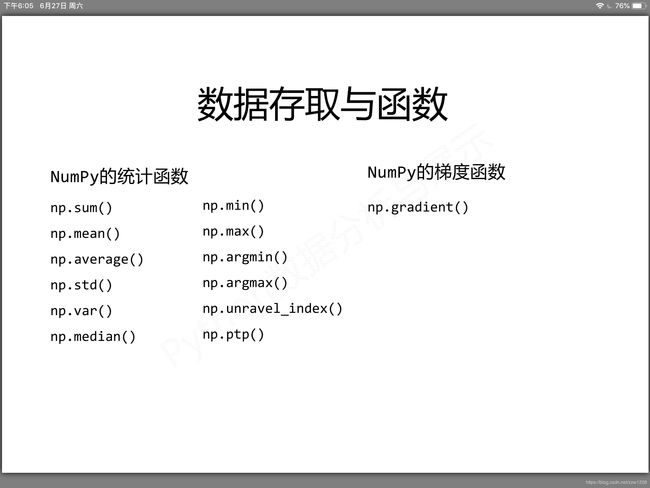Python数据分析与展示之NumPy数据存取与函数学习笔记手札及代码实战
NumPy数据存取与函数
- 学习笔记手札及单元小结
- 数据的CSV文件存取
- 多维数据的存取
- NumPy的快捷文件存取
- NumPy的随机数函数
- NumPy的统计函数
- NumPy的梯度函数
学习笔记手札及单元小结
数据的CSV文件存取
CSV文件,请在IPython平台运行
import numpy as np #引入numpy库,模块别名为np
a = np.arange(100).reshape(5,20)
np.savetxt('a.csv',a,fmt='%d',delimiter=',')
a = np.arange(100).reshape(5,20)
np.savetxt('a.csv',a,fmt='%.1f',delimiter=',')
b = np.loadtxt('a.csv',delimiter=',')
b
Out[8]: #out后面为输出结果
array([[ 0., 1., 2., 3., 4., 5., 6., 7., 8., 9., 10., 11., 12.,
13., 14., 15., 16., 17., 18., 19.],
[20., 21., 22., 23., 24., 25., 26., 27., 28., 29., 30., 31., 32.,
33., 34., 35., 36., 37., 38., 39.],
[40., 41., 42., 43., 44., 45., 46., 47., 48., 49., 50., 51., 52.,
53., 54., 55., 56., 57., 58., 59.],
[60., 61., 62., 63., 64., 65., 66., 67., 68., 69., 70., 71., 72.,
73., 74., 75., 76., 77., 78., 79.],
[80., 81., 82., 83., 84., 85., 86., 87., 88., 89., 90., 91., 92.,
93., 94., 95., 96., 97., 98., 99.]])
b = np.loadtxt('a.csv',dtype=np.int,delimiter=',')
b
Out[10]:
array([[ 0, 1, 2, 3, 4, 5, 6, 7, 8, 9, 10, 11, 12, 13, 14, 15,
16, 17, 18, 19],
[20, 21, 22, 23, 24, 25, 26, 27, 28, 29, 30, 31, 32, 33, 34, 35,
36, 37, 38, 39],
[40, 41, 42, 43, 44, 45, 46, 47, 48, 49, 50, 51, 52, 53, 54, 55,
56, 57, 58, 59],
[60, 61, 62, 63, 64, 65, 66, 67, 68, 69, 70, 71, 72, 73, 74, 75,
76, 77, 78, 79],
[80, 81, 82, 83, 84, 85, 86, 87, 88, 89, 90, 91, 92, 93, 94, 95,
96, 97, 98, 99]])
多维数据的存取
b = np.loadtxt('a.csv',dtype=np.int,delimiter=',')
b
Out[10]:
array([[ 0, 1, 2, 3, 4, 5, 6, 7, 8, 9, 10, 11, 12, 13, 14, 15,
16, 17, 18, 19],
[20, 21, 22, 23, 24, 25, 26, 27, 28, 29, 30, 31, 32, 33, 34, 35,
36, 37, 38, 39],
[40, 41, 42, 43, 44, 45, 46, 47, 48, 49, 50, 51, 52, 53, 54, 55,
56, 57, 58, 59],
[60, 61, 62, 63, 64, 65, 66, 67, 68, 69, 70, 71, 72, 73, 74, 75,
76, 77, 78, 79],
[80, 81, 82, 83, 84, 85, 86, 87, 88, 89, 90, 91, 92, 93, 94, 95,
96, 97, 98, 99]])
a = np.arange(100).reshape(5,10,2)
a.tofile("b.dat",sep=",",format='%d')
a = np.arange(100).reshape(5,10,2)
a.tofile("b.dat",format='%d')
a = np.arange(100).reshape(5,10,2)
a.tofile("b.dat",sep=",",format='%d')
c = np.fromfile("b.dat",dtype=np.int,sep=",")
c
Out[18]:
array([ 0, 1, 2, 3, 4, 5, 6, 7, 8, 9, 10, 11, 12, 13, 14, 15, 16,
17, 18, 19, 20, 21, 22, 23, 24, 25, 26, 27, 28, 29, 30, 31, 32, 33,
34, 35, 36, 37, 38, 39, 40, 41, 42, 43, 44, 45, 46, 47, 48, 49, 50,
51, 52, 53, 54, 55, 56, 57, 58, 59, 60, 61, 62, 63, 64, 65, 66, 67,
68, 69, 70, 71, 72, 73, 74, 75, 76, 77, 78, 79, 80, 81, 82, 83, 84,
85, 86, 87, 88, 89, 90, 91, 92, 93, 94, 95, 96, 97, 98, 99])
c = np.fromfile("b.dat",dtype=np.int,sep=",").reshape(5,10,2)
c
Out[20]:
array([[[ 0, 1],
[ 2, 3],
[ 4, 5],
[ 6, 7],
[ 8, 9],
[10, 11],
[12, 13],
[14, 15],
[16, 17],
[18, 19]],
[[20, 21],
[22, 23],
[24, 25],
[26, 27],
[28, 29],
[30, 31],
[32, 33],
[34, 35],
[36, 37],
[38, 39]],
[[40, 41],
[42, 43],
[44, 45],
[46, 47],
[48, 49],
[50, 51],
[52, 53],
[54, 55],
[56, 57],
[58, 59]],
[[60, 61],
[62, 63],
[64, 65],
[66, 67],
[68, 69],
[70, 71],
[72, 73],
[74, 75],
[76, 77],
[78, 79]],
[[80, 81],
[82, 83],
[84, 85],
[86, 87],
[88, 89],
[90, 91],
[92, 93],
[94, 95],
[96, 97],
[98, 99]]])
需要注意,该方法需要读取时知道存入文件时数组的维度和元素类型,a.tofile()和np.fromfile()需要配合使用,可以通过元数据文件来存储额外信息。
NumPy的快捷文件存取
a = np.arange(100).reshape(5,10,2)
np.save("a.npy",a)
b = np.load("a.npy")
b
Out[24]:
array([[[ 0, 1],
[ 2, 3],
[ 4, 5],
[ 6, 7],
[ 8, 9],
[10, 11],
[12, 13],
[14, 15],
[16, 17],
[18, 19]],
[[20, 21],
[22, 23],
[24, 25],
[26, 27],
[28, 29],
[30, 31],
[32, 33],
[34, 35],
[36, 37],
[38, 39]],
[[40, 41],
[42, 43],
[44, 45],
[46, 47],
[48, 49],
[50, 51],
[52, 53],
[54, 55],
[56, 57],
[58, 59]],
[[60, 61],
[62, 63],
[64, 65],
[66, 67],
[68, 69],
[70, 71],
[72, 73],
[74, 75],
[76, 77],
[78, 79]],
[[80, 81],
[82, 83],
[84, 85],
[86, 87],
[88, 89],
[90, 91],
[92, 93],
[94, 95],
[96, 97],
[98, 99]]])
NumPy的随机数函数
import numpy as np
a = np.random.rand(3,4,5)
a
Out[3]:
array([[[0.92126078, 0.72702673, 0.13624911, 0.73092708, 0.42956826],
[0.95508714, 0.57926769, 0.03424191, 0.59152571, 0.02174399],
[0.42098051, 0.93879879, 0.84240545, 0.04235163, 0.45768729],
[0.62887218, 0.85697452, 0.44094573, 0.563129 , 0.993858 ]],
[[0.55746268, 0.96863765, 0.31039295, 0.53537751, 0.65815568],
[0.26423492, 0.82525228, 0.87460426, 0.86163507, 0.19211628],
[0.76989613, 0.56726312, 0.44005911, 0.4682608 , 0.05538174],
[0.87612542, 0.45498654, 0.1775557 , 0.72461702, 0.70123385]],
[[0.08351399, 0.06128516, 0.42343067, 0.86004714, 0.66739059],
[0.25322708, 0.63308245, 0.0344849 , 0.71008877, 0.41591252],
[0.04722793, 0.95979877, 0.59740886, 0.82616566, 0.71476045],
[0.83329752, 0.059742 , 0.13737899, 0.88026533, 0.0881806 ]]])
sn = np.random.randn(3,4,5)
sn
Out[5]:
array([[[-1.68621026, -0.54643652, 0.59114768, 0.55151255,
0.50860481],
[ 0.68583257, 1.76492401, 1.10093793, 1.57387225,
-0.45179255],
[ 0.22051625, -0.39438724, -1.31568633, 0.02240675,
-0.06721427],
[ 3.00847932, 1.22789191, 3.17766278, -0.65571714,
-0.22554802]],
[[-1.08297144, 0.12654454, 0.71503543, -3.15202389,
-0.61358609],
[ 1.03379153, 0.02344163, 1.22937763, -1.13211814,
-0.2089044 ],
[-0.75627669, 0.43724419, 0.57417111, 1.28755106,
0.65818801],
[-0.09347696, -0.11455071, -0.20818887, 0.23148983,
-0.90157041]],
[[ 0.01811455, 1.44858211, -0.13296883, 1.30496287,
0.5481228 ],
[-1.50693645, -0.88008349, 0.53535135, -0.21610831,
0.83826012],
[-0.30166713, -0.37950129, -1.1221579 , -2.06424955,
-1.04543235],
[ 1.76997155, -0.53683235, -1.70964818, 0.37693068,
-0.40056297]]])
b = np.random.randint(100,200,(3,4))
b
Out[7]:
array([[173, 114, 192, 155],
[136, 166, 193, 135],
[191, 135, 183, 176]])
b = np.random.randint(100,200,(3,4))
b
Out[9]:
array([[162, 182, 118, 155],
[108, 147, 116, 119],
[108, 197, 131, 125]])
np.random.seed(10)
np.random.randint(100,200,(3,4))
Out[11]:
array([[109, 115, 164, 128],
[189, 193, 129, 108],
[173, 100, 140, 136]])
np.random.seed(10)
np.random.randint(100,200,(3,4))
Out[13]:
array([[109, 115, 164, 128],
[189, 193, 129, 108],
[173, 100, 140, 136]])
函数小试
import numpy as np
a = np.random.randint(100,200,(3,4))
a
Out[3]:
array([[178, 175, 192, 186],
[197, 155, 120, 135],
[119, 105, 176, 109]])
np.random.shuffle(a)
a
Out[5]:
array([[178, 175, 192, 186],
[197, 155, 120, 135],
[119, 105, 176, 109]])
np.random.shuffle(a)#改变数组x
a
Out[9]:
array([[119, 105, 176, 109], #看这里,与上面有何不同
[178, 175, 192, 186],
[197, 155, 120, 135]])
import numpy as np
a = np.random.randint(100,200,(3,4))
a
Out[3]:
array([[192, 140, 102, 136],
[131, 137, 122, 188],
[111, 103, 157, 124]])
np.random.permutation(a)
Out[4]:
array([[111, 103, 157, 124],
[131, 137, 122, 188],
[192, 140, 102, 136]])
a
Out[5]: #a的数组与上面相同,没有变化
array([[192, 140, 102, 136],
[131, 137, 122, 188],
[111, 103, 157, 124]])
import numpy as np
b = np.random.randint(100,200,(8,))
b
Out[3]: array([114, 164, 148, 105, 113, 187, 113, 164])
np.random.choice(b,(3,2),replace=False)
Out[4]:
array([[105, 164],
[164, 114],
[148, 187]])
np.random.choice(b,(3,2),p=b/np.sum(b)) #注意p=b/np.sum(b)的变化
Out[5]:
array([[187, 105],
[164, 164],
[105, 114]])
正态分布
import numpy as np
u = np.random.uniform(0,10,(3,4))
u
Out[3]:
array([[3.29156207, 1.68210832, 5.69714857, 5.45456271],
[4.61777858, 8.88234325, 6.39212963, 5.92899842],
[3.59607425, 8.80170278, 2.77462772, 9.58831913]])
n = np.random.normal(10,5,(3,4))
n
Out[5]:
array([[13.7804125 , 12.61610026, 16.7549758 , 7.36912023],
[ 8.4167832 , 6.3346798 , 17.30410627, 20.55554637],
[11.52397011, 11.74722443, 16.11041637, 8.30900004]])
NumPy的统计函数
import numpy as np
a = np.arange(15).reshape(3,5)
a
Out[3]:
array([[ 0, 1, 2, 3, 4],
[ 5, 6, 7, 8, 9],
[10, 11, 12, 13, 14]])
np.sum(a)
Out[4]: 105
np.mean(a,axis=1)
Out[5]: array([ 2., 7., 12.])
np.mean(a,axis=0)
Out[6]: array([5., 6., 7., 8., 9.])
np.average(a,axis=0,weights=[10,5,1])#求加权平均值,例4.1875=2*10+7*5+1*12/(10+5+1)
Out[7]: array([2.1875, 3.1875, 4.1875, 5.1875, 6.1875])
np.std(a) #求标准差
Out[8]: 4.320493798938574
np.var(a) #求方差
Out[9]: 18.666666666666668
import numpy as np
b = np.arange(15,0,-1).reshape(3,5)
b
Out[3]:
array([[15, 14, 13, 12, 11],
[10, 9, 8, 7, 6],
[ 5, 4, 3, 2, 1]])
np.max(b)
Out[4]: 15
np.argmax(b) #扁平化后的下标
Out[5]: 0
np.unravel_index(np.argmax(b),b.shape)#重塑成多维下标
Out[6]: (0, 0)
np.ptp(b)#求最大值与最小值的差
Out[7]: 14
np.median(b) #求中位数
Out[8]: 8.0
NumPy的梯度函数
import numpy as np
a = np.random.randint(0,20,(5))
a
Out[3]: array([14, 19, 10, 8, 5])
np.gradient(a)
Out[4]: array([ 5. , -2. , -5.5, -2.5, -3. ])#-2。=(10-14)/2存在两侧值;-3.=(5-8)/1只有一侧值
b = np.random.randint(0,20,(5))
b
Out[6]: array([ 7, 17, 7, 2, 12])
np.gradient(b)
Out[7]: array([10. , 0. , -7.5, 2.5, 10. ])
import numpy as np
c = np.random.randint(0,50,(3,5))
c
Out[3]:
array([[22, 31, 9, 24, 37],
[38, 25, 21, 10, 13],
[48, 20, 45, 39, 28]])
np.gradient(c)
Out[4]:
[array([[ 16. , -6. , 12. , -14. , -24. ], #最外层维度的梯度
[ 13. , -5.5, 18. , 7.5, -4.5],
[ 10. , -5. , 24. , 29. , 15. ]]),
array([[ 9. , -6.5, -3.5, 14. , 13. ], #第二层维度的梯度
[-13. , -8.5, -7.5, -4. , 3. ],
[-28. , -1.5, 9.5, -8.5, -11. ]])]










